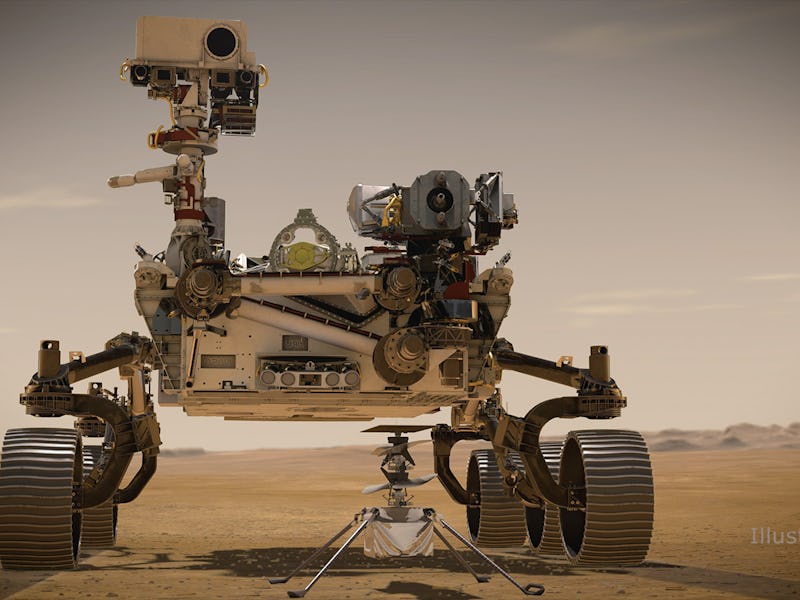After a tense seven minutes, NASA Perseverance rover lands safely on Mars
The robot will begin a quest to find life beyond Earth.

On Thursday, NASA's Perseverance rover safely touched down on Mars at 3:55 p.m. Eastern time after traveling through space for nearly seven months.
From here, the rover will begin its 687-day mission on Mars, the equivalent of one Martian year, packed with a unique set of tools aimed at finding signs of ancient microbial life on Mars.
Video of Perseverance landing
The Perseverance team celebrates the successful touchdown of the rover after a tense "seven minutes of terror."
The Perseverance rover launched at 7:50 a.m. Eastern time on July 30, from the Space Launch Complex 41 at Cape Canaveral Air Force Station, where the rover was strapped onto a United Launch Alliance Atlas V 541 rocket.
The goal of the Perseverance mission is to look for clues of ancient life on Mars.
READ MORE PERSEVERANCE ROVER NEWS FROM INVERSE
While Mars is fairly dry today, evidence collected by previous Martian missions suggests the Red Planet was once a warm, wet planet with conditions similar to those on Earth today. This leads scientists to believe that Mars may have once been a habitable world during its early history.
The first image from Perseverance on Mars
This is the first image the Mars rover Perseverance took from Jezero Crater, where it safely landed on February 18. The rover will look for evidence of past life on Mars.
7 minutes of terror
Perseverance underwent a series of intricate and terrifying maneuvers in order to land on Mars. Landing on Mars is no easy feat, and only about half of the missions sent to the Red Planet have successfully made it there.
As it made its descent to the red planet, Perseverance went offline as ground control lost communication with the rover once it entered the Martian atmosphere for a routine, yet still nerve racking, period of time known as the 'seven minutes of terror.'
Perseverance entered the Martian atmosphere at 3:48 p.m. Eastern time. Due to an 11-minute delay in transmissions from Earth to Mars, the rover had to stick the landing on its own.
Before entering the atmosphere, Perseverance's entry capsule separated from the spacecraft that has been carrying the rover and its helicopter companion, Ingenuity.
After it entered the atmosphere, the spacecraft deployed a parachute about seven miles above the surface of Mars. The spacecraft soon separated from the parachute and was lowered onto the surface using a set of cables.
Once Perseverance's wheels touched the surface of Mars, it cut the cables and safely landed on the planet.
Perseverance landing celebration
The Perseverance landing team celebrates the successful touchdown of the rover after "seven minutes of terror" in which communication with the rover was scant.
What are the Perseverance mission goals?
Perseverance landed in the Jezero Crater — a 28-mile wide, 1,600-foot deep crater located in a basin slightly north of the Martian equator.
Jezero Crater once housed a lake estimated to have dried out 3.5 to 3.8 billion years ago, which makes it an ideal destination to hunt for ancient, microbial life that may have once existed on Mars.
Perseverance will collect samples of rock and dust from the Martian surface using its nine drill bits. But unlike previous missions to Mars, Perseverance will stow away those samples for a future sample return mission that will allow scientists to examine them in a lab on Earth.
The samples move through the belly of the robot, and into the Adaptive Caching Assembly System, where they are assessed and processed. The assembly system contains seven motors, and more than 3,000 parts including the Sample Handling Arm that the rover will use to hold sample tubes.
Perseverance will then leave the samples on Mars so that they can be picked up by another mission in the next few years.
The rover is set to spend 687 days on Mars, the equivalent of one Martian year. But if it's anything like its predecessors, Perseverance will likely extend its stay on the Red Planet.
This article was originally published on